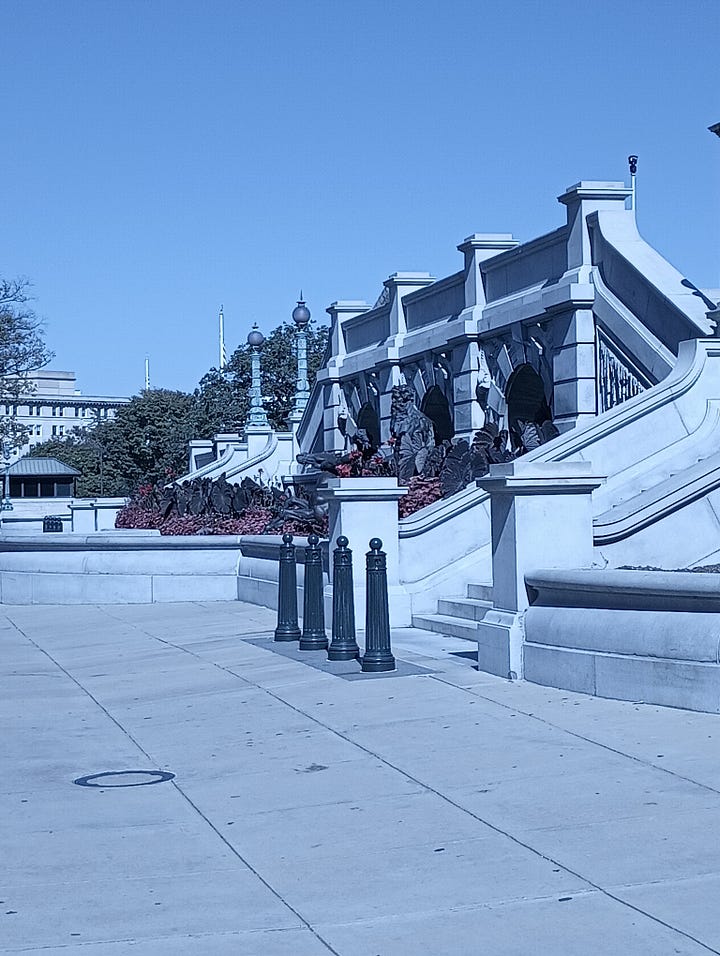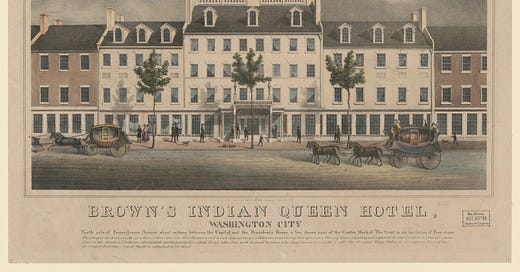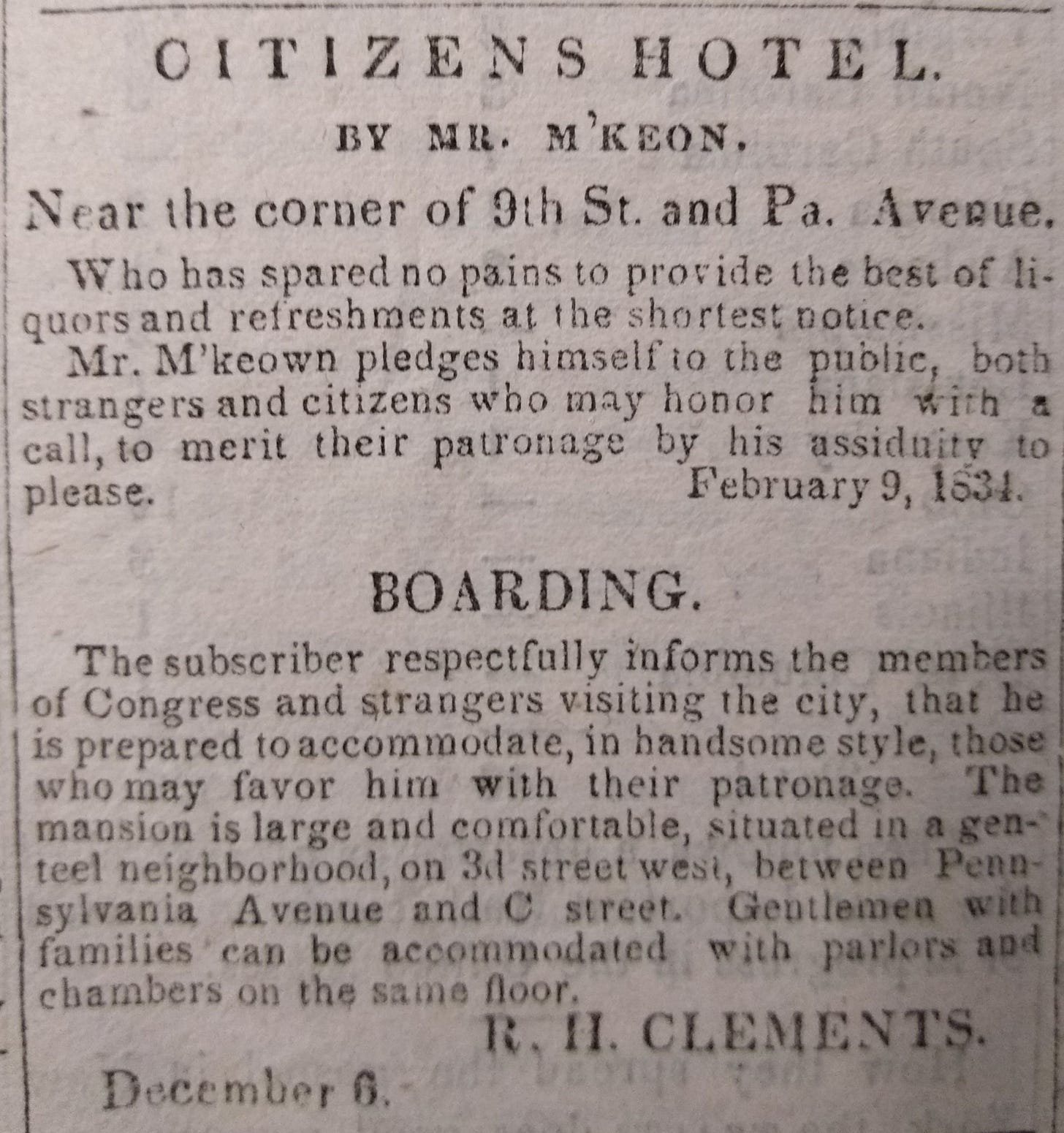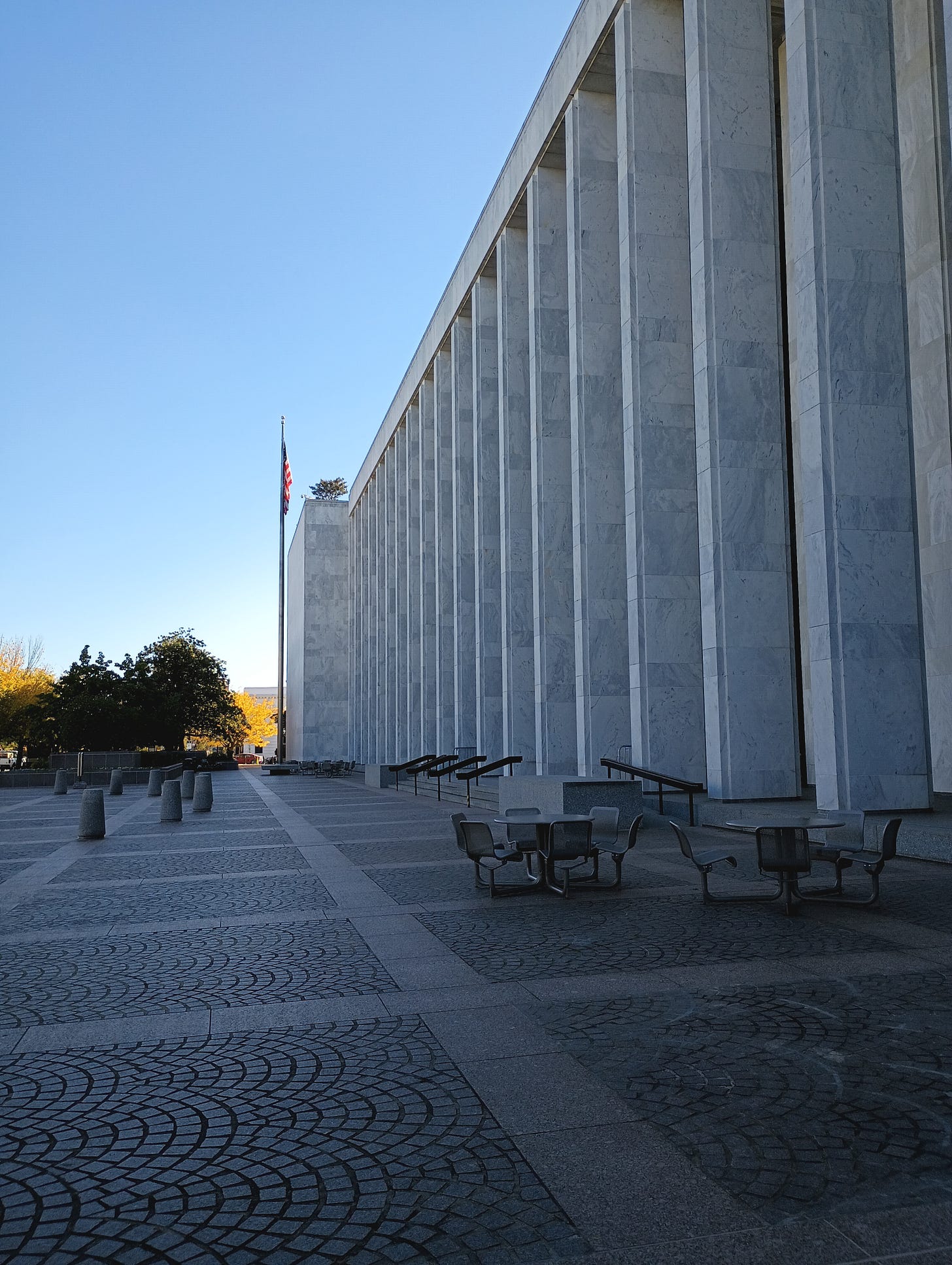CONGRESSMAN DAVY: "Washington City"
Tracing the 19th Century geography of a 21st century musical.
It's a swamp we live on / A sinking quagmire stink
That men would build a city here / It really makes you think
Mosquitoes eat us / The mud is plenty thick
A perfect place it seems to me / To practice politics
— “Washington City” from Congressman Davy
As I started scratching out notes and commencing research in the fall of 2014 for Congressman Davy ( a new musical I have written with Dean Schlabowske of the Waco Brothers), I quickly determined that the setting of the play had to be 7th and Pennsylvania Avenue NW.
Today, the Federal Trade Commission (FTC) occupies the southeast side of that intersection. Across the avenue, there are two office buildings. But in 1835, it was an epicentre of the hospitality industry. Mrs. Ball’s Boarding House stood on the FTC site. And the elegant Brown’s Indian Queen Hotel (above) stood opposite.
Davy Crockett stayed in both establishments as a congressman in the 1820s and 1830s. He resided at the more downscale Mrs. Ball’s for most of his three terms in the U.S. House of Representatives. (It was a place where legislators often shared a bed to economize.) Yet Crockett appears to have swapped addresses, and moved into the more expensive Indian Queen, at some point in his third term in office (1833-1835).
Playwrights are always looking for a tight locus for dramatic action. So dueling establishments battling for Crockett’s custom across Pennsylvania Avenue NW was an extraordinarily appealing framework for a musical. This was especially true since Crockett’s move into more luxurious surroundings coincided with his political marriage of connivance and convenience with the Whig Party. (Its officials not only were funded his speaking tour of the Northeast U.S. in 1834, but also touted him as a possible presidential candidate.)
I had Mrs. Ball already in mind as a part of the musical. But as a dramatist, I wanted two strong women characters vying for Congressman Crockett’s business. Sadly for my scheme, the proprietor of Brown’s Indian Queen was a man named Jesse Brown — a hotelier with a sterling reputation and a knack for charming his guests.

I felt resigned to the tug of history until my research on another main character of Congressman Davy — pioneering journalist Anne Royall — provided a “Eureka!” moment. In Bessie Rowland James’ Anne Royall’s U.S.A. (1972), I happened across a passage on the Indian Queen Hotel that solved my conundrum instantly:
The main stay of the Indian Queen,” said Mrs. Royall, “ is Mrs. Brown. She is to be seen everywhere, late and early, and not a particle of the culinary department is performed that does not pass under her eye.”
Suddenly, I had found my Mrs. Brown to match with Mrs. Ball. (Sorry, Jesse.)
My explorations of Washington City geography offered plenty of inspiration for Congressman Davy — even though the key intersection Of Pennsylvania and 7th NW scarcely looks as it did in the 1830s.
Indeed, very little of that early era in the history of “Washington City” has survived to the present day. But walk a bit north along 7th Street from Pennsylvania Avenue, and through Indiana Plaza, and you will behold a sight that Crockett himself would have seen in the 1830s: three surviving buildings on the 600 block of Indiana Avenue that were first erected in the 1820s.

In the years of researching and writing Congressman Davy, I would visit this intersection often. It was always inspiring to stand in this places and imagine the city of that moment — just as Crockett and my other characters might have seen it in their own time.
Anne Royall and the Library of Congress
A perfumed fragrance / Of sweat and horse manure
And stench invades the White House / From a filthy open sewer
A wretched city / On earth it has no peer
But if you have the stomach / You can make a profit here
— “Washington City” from Congressman Davy
The “Washington City” of the early and mid-1830s comes alive vividly in the pages of Anne Royall’s weekly newspaper, Paul Pry, which she published under that name until late 1836. (She decided to rename her newspaper as The Huntress, which appeared under that title until a few months before her death in 1854.)
What was Washington City like in that era? What can be gleaned from Paul Pry’s advertisements alone were a handy reservoir for my imagination. In a musical that is centered in part on the hotel trade, seeing the two advertisements below for Mr. M’keon’s “Citizens Hotel” and a boarding house run by “R.H. Clements” thrust me directly into the lingo of the business (not to mention an “assiduity to please”):
Anne Royall did not spare her hometown from the lash of her journalism. On June 30, 1832, she began a lengthy disquisition about the spread of cholera in the city with the following words that were likely penned as heat and humidity took a firm summer grip on Washington City (punctuation unaltered from the original):
That the location of Washington City is unhealthy cannot be denied. The principal part of the city,(Pennsylvania avenue,)being built in a marsh, which a common shower overflows, and from want of sewers and proper attention, or rather no attention at all, it is overspread with standing puddles of water from years end to years end, and from the negligence of the corporation, these puddles, as well as the gutters, are choked up with filth, which being acted upon by the heat of the sun, has become green and putrid. This is not all, the whole of the flat land between the settled part of the city and the Potomac, much of which is marsh, is also overspread with pools of fœtid water.
As I found inspiration in seeing where Davy Crockett lived, I often wondered about Anne Royall’s places of residence in the Washington City. As I dug deeper, I found that Anne Royall was very much a creature of Capitol Hill — with a deep association with the Library of Congress.
The Library of Congress (LOC) was where Royall sold new editions of Paul Pry and The Huntress every Saturday. It seems that this was not only because she likely felt that the politicians and functionaries of the growing U.S. government were the prime audience for her paper. Capitol Hill was Anne Royall’s neighborhood.
One of the first addresses where we know Royall lived was in Carroll Row — a group of buildings right across from the Capitol on First Street, between East Capitol Street and A Street. Those buildings were demolished eventually to make way for the Library of Congress’ Thomas Jefferson Building.


The topography of Capitol Hill’s core has changed profoundly over almost two centuries. So much so that it makes scouting out Anne Royall’s other residences a vexing task.
At one point, Royall lived and worked around the corner from Carroll Row “at the corner of East Capitol and 2nd Streets, near the Hill Market.” (That market is reported to have stood in the middle of East Capitol, between the present-day Supreme Court and the LOC’s Thomas Jefferson Building.)
A third Anne Royall address also has a Library of Congress connection. Eventually she ended up living slightly southeast of the Capitol in the (now-vanished) B Street between 1st and 2nd Streets. Today, that location is smack dab in the middle of another Library of Congress site: the LOC’s James Madison Building.
Wandering Capitol Hill and chasing down Anne Royall did not yield a building where she lived that remains today. But it did give me a sense of how “small” Washington City was in this era. How important it was to find a place to live and work close to the Capitol itself.
As a writer working in the teeming metropolis that we know today as the DMV, it was important as I wrote Congressman Davy to get a sense of that closeness: a community situated in an unhealthy clime, engaged in persistent, fierce and vitriolic polemic from which there was very little possibility of any day-to-day escape.
The Friday, November 1, 2024 staged reading of Congressman Davy at the True Reformer Building on U Street NW is free, but reservations are required for admission. Book a place here.
Listen to “Poison Pens” — a free teaser track for the reading performed by Deano & Jo.






